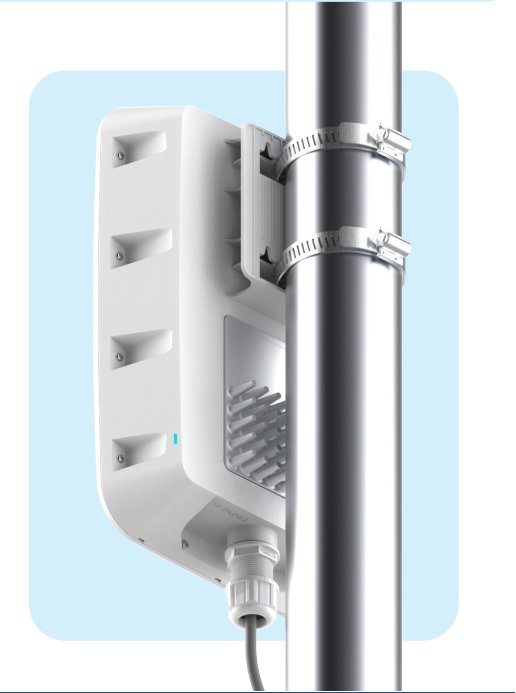Band steering is a technique used in wireless networking, particularly in the context of Wi-Fi. It optimizes the distribution of devices between different frequency bands, typically between the 2.4 GHz and 5 GHz bands.
In a Wi-Fi 6 (802.11ax) wireless network, band steering becomes particularly important due to the increased data rates and capacity that Wi-Fi 6 offers.
Here’s why band steering is crucial when implementing a new Wi-Fi 6 wireless network at an RV park:
Optimizing Network Capacity:
Wi-Fi 6 introduces technologies like Orthogonal Frequency Division Multiple Access (OFDMA) and Basic Service Set (BSS) Coloring, which enhance the capacity of the wireless network. Band steering helps distribute devices across different bands, reducing congestion and maximizing the available capacity.
Leveraging the 5 GHz Band:
Wi-Fi 6 operates in both the 2.4 GHz and 5 GHz bands. The 5 GHz band generally provides faster data rates and is less congested than the 2.4 GHz band. Band steering encourages capable devices to connect to the 5 GHz band, optimizing performance and freeing up capacity on the 2.4 GHz band for devices that may not support 5 GHz.
Improving Device Performance:
Wi-Fi 6 supports more simultaneous connections and offers improved performance compared to previous Wi-Fi standards. Band steering ensures that devices capable of utilizing the features of Wi-Fi 6, such as increased throughput and better efficiency, are directed to the appropriate band for an optimal experience.
Enhancing Roaming Efficiency:
RV parks often have large areas, and visitors’ devices may move around. Band steering helps in seamless roaming by steering devices to the appropriate band as they move within the park. This ensures a consistent and reliable connection without interruptions.
Addressing Interference Issues:
The 2.4 GHz band is more susceptible to interference from various devices, including household appliances and other Wi-Fi networks. Band steering helps mitigate interference issues by encouraging devices to connect to the less congested and interference-prone 5 GHz band.
Implementing band steering in a Wi-Fi 6 network at an RV park is vital for optimizing capacity, improving device performance, enhancing roaming capabilities, and addressing potential interference issues. It ensures that the network operates efficiently, providing a reliable and high-performance wireless experience for all users in the RV park.
Large RV parks can benefit significantly from advanced outdoor access points like the GNS Wireless XV2-23T, especially with features like band steering. Here’s why such a device is essential for large RV parks:
High Capacity and Throughput:
Large RV parks often attract a substantial number of visitors, each with multiple wireless devices. The XV2-23T, equipped with Wi-Fi 6 technology and band steering, helps distribute devices efficiently across different frequency bands, optimizing capacity and maximizing throughput. This ensures that all users experience fast and reliable connections.
Mitigating Interference:
RV parks can be challenging environments with potential interference from nearby networks, electronic devices, and other wireless signals. Band steering in the XV2-23T helps direct devices to less congested and interference-free frequency bands
Seamless Roaming:
RV park visitors are likely to move around the premises, and seamless roaming is crucial for maintaining a stable connection. Band steering assists in directing devices to the most suitable band as users roam, ensuring a smooth transition without disruptions.
Enhanced Device Compatibility:
With the growing number of Wi-Fi-enabled devices, compatibility becomes a key consideration. The XV2-23T, with band steering, ensures that devices capable of utilizing the advanced features of Wi-Fi 6 are directed to the appropriate band, optimizing their performance and enhancing the overall network efficiency.
Improved User Experience:
Band steering contributes to a better user experience by intelligently managing device connections. Users benefit from faster speeds, reduced latency, and a more stable connection, especially in scenarios where numerous devices are connected simultaneously.
Optimal Coverage and Range:
Large RV parks require access points with robust coverage and extended range. The XV2-23T, designed for outdoor use, provides reliable coverage over a wide area, ensuring that all areas of the RV park have access to high-quality Wi-Fi.
Future-Proofing the Network:
Wi-Fi 6 is the latest wireless standard, offering advanced features and improved performance. Implementing devices like the XV2-23T ensures that the RV park’s network is future-proofed, ready to accommodate the increasing number of devices and evolving technology standards.
In summary, the GNS Wireless XV2-23T outdoor access point, with band steering functions, is well-suited for large RV parks. It addresses the specific challenges of high user density, interference, roaming, and device diversity, providing a robust and reliable wireless infrastructure for both park management and visitors.

